Well, here we are! Today we kicked off Team ’22 with the first Keynote! I’m excited to see what Atlassian has in store. Honestly, I don’t know how many of the keynotes will have relevant announcements in them, but the structure I expect is to have this one give the 10 km view of everything they have been doing, and then have some of the other keynotes go into detail about specific parts. But, this is Atlassian, so who knows!

Future Rodney: Atlassian did something extraordinary this year – as in I wish they wold have done this every year! They’ve already posted all the keynotes to their youtube Channel! I’m posting the video here for you to watch if you want to. However, if you just want the recap, keep reading!
Dom Price doing a introduction!
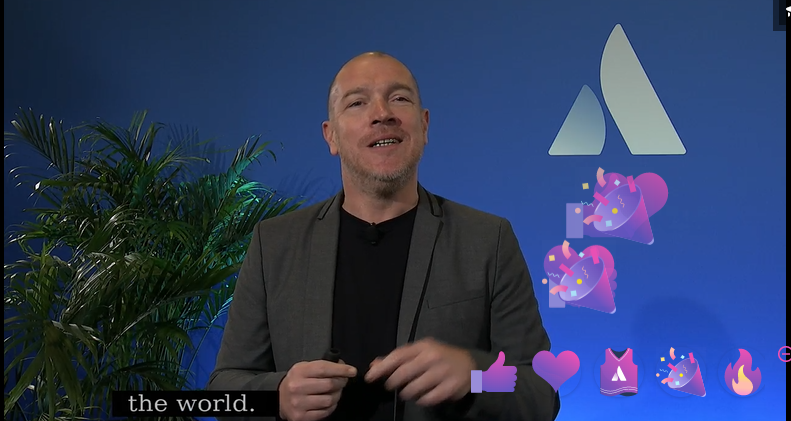
As always, a disclaimer. Consider it my disclaimer too. Just because Atlassian spoke on it, doesn’t mean it’s a done deal.

Alright, I’m still a bit jealous I couldn’t be a part of the crowd here. But Health comes first.

Quick shot of the team watching this together while Scott talks about Ukraine.

The theme of the first Keynote in larger than life lettering. Roll Credits!

Scott Announcing Atlas. This is one of Atlassian’s new offerings, meant to show the Who, What, When, and Why of what’s going on in your Organization.

A Better look at the new Logo. Kind of slick, to be honest.

Atlas is meant to achieve all of these and more. Atlas was covered more in another Keynote, so it was just glossed over here.

A Bit of talk about the “Atlassian Platform” – the family of tools they have built into the Cloud.

Probably the most interesting news of the day – Atlassian is investing in some BI and Analytics tools. IT’s all about taking the information that is already in your Atlassian toolset, and organizing it to let you have the details you need when you make decisions.

The interesting thing is that this won’t only take Data from your Atlassian tools, but other sources as well!

For example, you can map your revenue from Snowflake against your Engineering output to see if you are keeping pace.

Atlassian also revealed that they are expanding the number of users allowed per instance, their uptime SLAs, and even their performance over last year. I will say they cheated a bit by specifying Confluence. Jira tends to be harder hit by complex configurations.

They also have plans to add FedRAMP and BYOK Encryption to their Atlassian Platform.

When the Server Sunset was announced, one of my biggest criticisms was that some agencies, especially FinTech, required On-Prem to maintain security. This seems to be saying “These companies decided otherwise.” Features like the Certifications above and Data Residency has allowed them to Migrate to Cloud.

Additionally, Atlassian has been expanding integrations that works with their Smart Links in Confluence. Posting a Link to any of these in Confluence generates an object with the details.

And then there is the Atlassian Marketplace. 5,600 Apps and counting for Atlassian Cloud.

Then the first keynote ended with a transition showing Atlassian, their Products, Marketplace Partners, and Integrations. It was a nice way to wrap it up…or it would have been but…

Except they went Right into the Work Management Keynote, only pausing long enough to change presenters. To be honest, it felt a bit awkward, like “Why call this a separate Keynote?” This keynote started with this problem statement: Companies are using more tools than ever – illustrated by this screen.

They continue with the problem statement: “And not all teams are using the same set of tools.”

So the question becomes, “How do we Work Differently, Together?”

They then showed a brief Teaser video to show off their new tool, Atlas. You can click this link to go directly to that part of the Keynote video, as they haven’t posted the teaser video by itself online yet.
They then start to go into how Atlas will work in detail. First, they made a big point that as part of the Atlassian Platform, Atlas will support any Smart Links that Confluence currently supports.

The point of Atlas is to map work – where ever it is done – to a goal our outcome.

And they mean everywhere work is done. Atlassian integrating with Asana – I didn’t think I’d see the day.

The whole point is to get away from this: The dreaded Status Update Sync. Also, this is my calendar for most weeks.

Atlas tries to take updates asynchronous by reminding you weekly to post an update that others can read when they are ready. These Updates, though, are limited to 280 Characters, which to be honest can be a double-edge sword. Yeah, it’s short and sweet so people are more likely to read it, but it completely removes any nuance you could provide. You simply don’t have the character count.

Something I couldn’t really capture in screenshots, but this tool lets you set estimated completion dates as Quarters, months, or dates. The idea here is that you can give a rough estimate to start with, then dial it in as you get closer to being done.

They then go into there are several ways to view “What team you’re on.” One is the traditional Tree hierarchy.

Another is who you’re actually interacting with day-to-day and what you’re working together on.

Atlas will reflect both views.

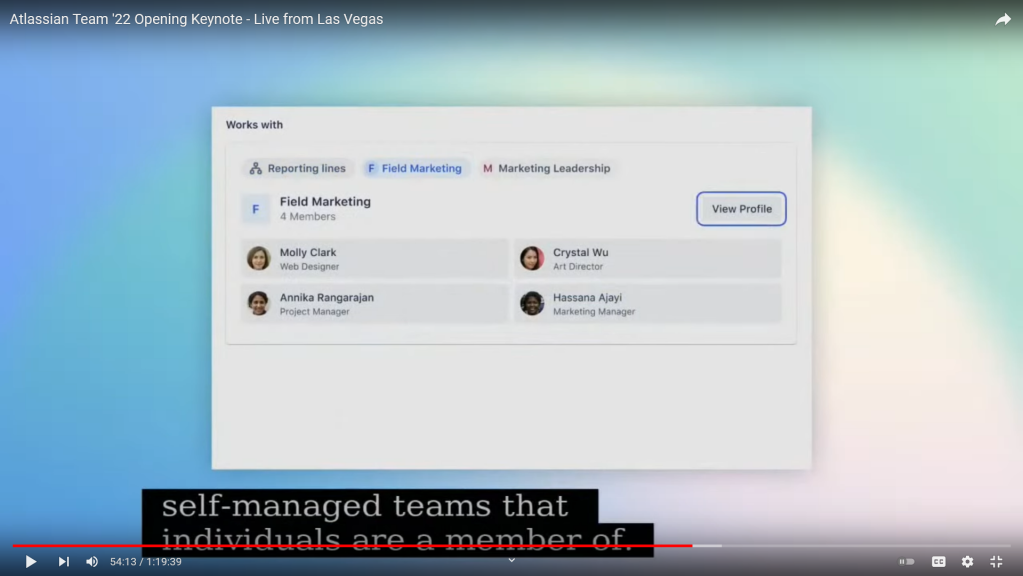
The whole point is you can find the status of a given project of interest without having to know who to ask.

And you can start using the Atlas beta free today. I’ve already signed up for it for testing. My thoughts on Atlas? Well, it seems like a tool that to get any value out of, EVERYONE in the Org needs to use it. You can only get that kind of adoption from a mandate from the top. Most of Atlassian products tend to grow from the bottom up though – so that alone gives me some pause.
Let me explain, for people to keep using this tool after the mandate, they are going to need to see value out of it fast. Otherwise, it’s going to be “just another thing I have to do.” It’s the same problem you see with ridiculously long Jira screens with too many required fields – people are going to enter junk data just so they can get on with their real work. That is a real danger with something like this if they can’t see the benefit directly.

We then moved on to the next part of the Keynote: Confluence Cloud. They first introduced Smart Links. Basically, you type in a URL to a given resource, be that a Youtube or Loom video, Miro Board, Jira Issue, Google Doc, or a myriad of other sources, and Confluence converts that to a macro with the information displayed directly.

Being able to edit a Miro board directly in Confluence would be amazing, tbh.

Another new feature coming to Confluence: Being able to make charts from your table data in Confluence. This very much feels like a “Take that, Excel” move.

One new Confluence feature I’m excited about is Presenter Mode. This takes your Confluence page, removes the header, tabs, and sidebar, and lets you see it in a way that can be displayed to everyone.


Another thing they are adding is the ability to add Emoji directly in the Confluence window to pages, reactions, and comments. No more going to a third-party site, copying the emoji, and going back to Confluence.
This is especially funny, as there was a time not terribly long ago when certain emoji could crash Bitbucket, Confluence, Jira Server running on older versions of MySQL. Not to get too in the weeds, but the older MySQL Databases couldn’t handle 4-byte Unicode that the Emoji used, but Jira and Confluence could, so when the systems would try to save the Unicode to the DB, it’d cause a cascade of problems that would require a restart to fix. I wish I was joking, but I had to restart Bitbucket once because someone tried to use a tree (🌲) in their git commit.
So it’s funny to now see Atlassian embrace the Emoji.

And Then there was automation for Confluence. Create pages based on rules, schedules, etc.

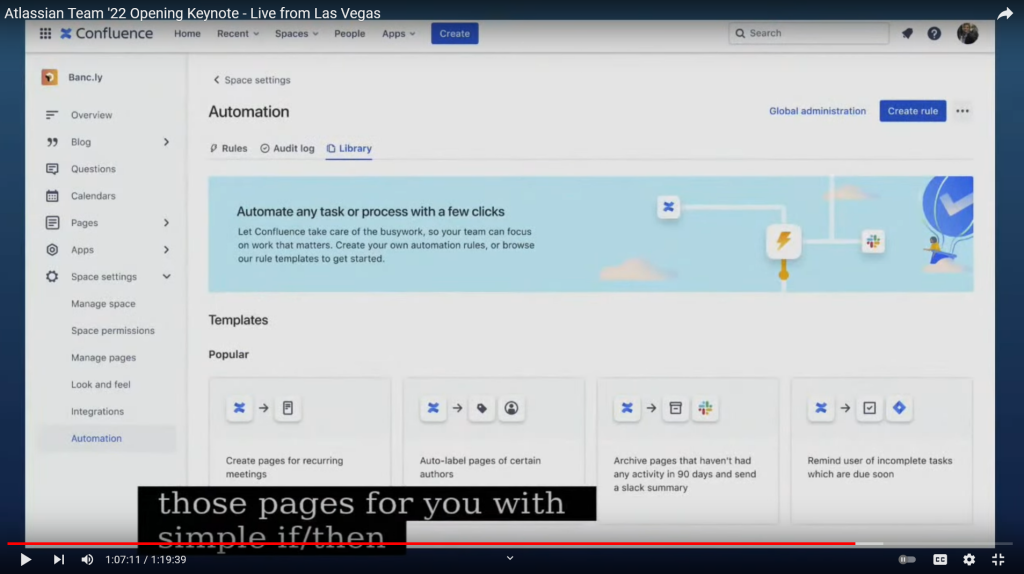
And as one last announcement, Microsoft Teams will be the first Non-Atlassian product that will let you edit Confluence Documents within it’s App directly.


Then we Get to move onto Trello and Jira Work Management. If you know me, I’m a huge fan of both these tools, so I want to see what’s new here!

Starting with Trello, we have the recently announced Calendar mode. I’ve already stated how I use Trello for Vacation Planning, and having a Calendar mode will take that to the next level.

They also noted how many people use it for their own personal work management – of which I’m one. Yep, a blog about Jira is managed in Trello. I’ve always found it funny, but it works for me.

Next we have some automated ways to get tasks onto your board. I know my friend and noted Trello Queen Brittany Joiner has already used Email to board in some of her automation flows, but on top of that new feature we also have Slack to board – which lets you create a card from a Slack message.
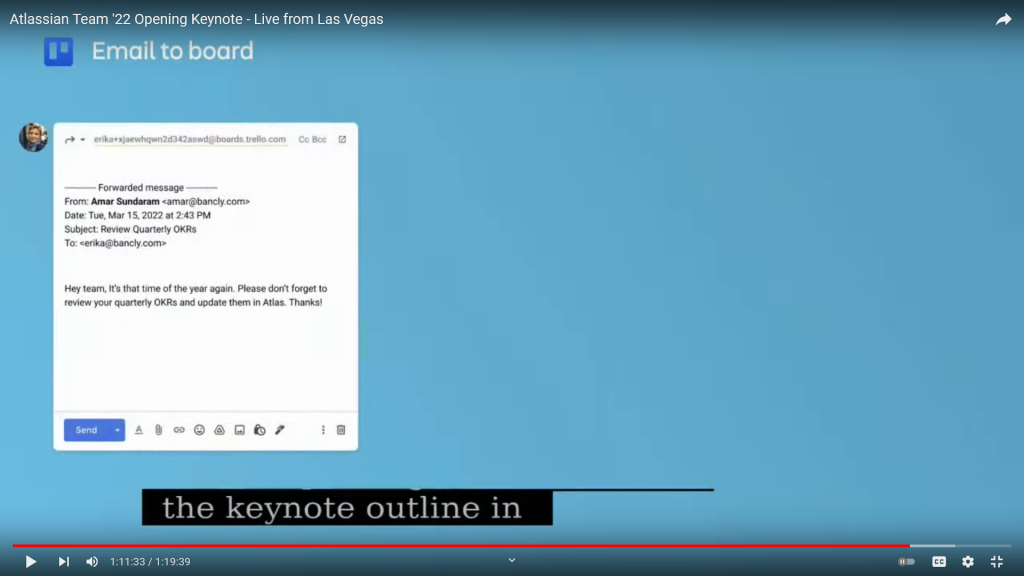

You can now have recurring Cards for those tasks you need to do regularly.

And next, Trello for Enterprise. Which, I’m sorry. I’ve had requests to use Trello in the workplace for most of my career working with Atlassian Products. It’s. About. Time.

Now we get to move on to Jira Work Management. It’s been a year since it’s launch, so I’m happy to see they’re still investing in it.

I love this slide. I’ve had a hand in suggesting three of these four views.
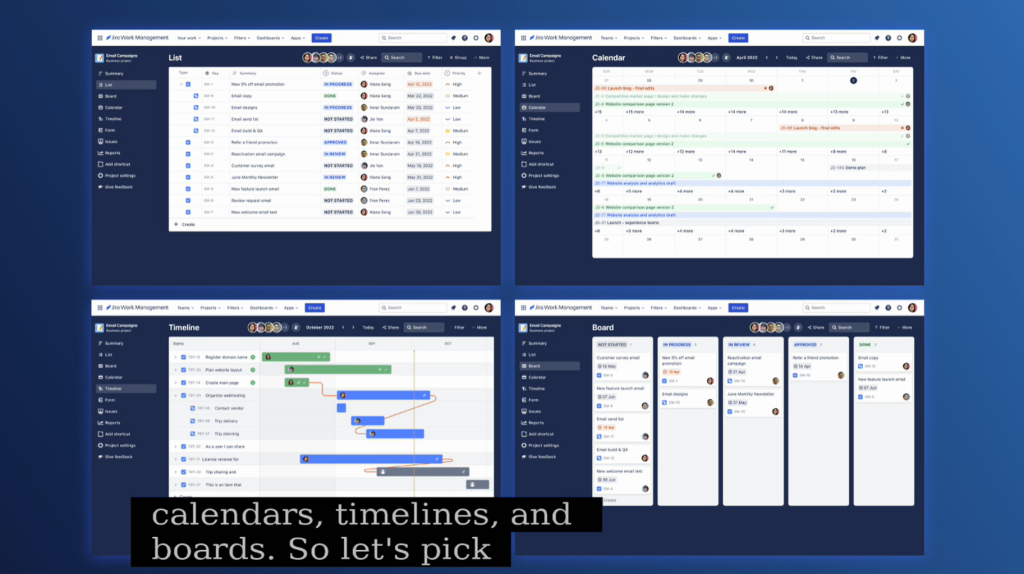
List view was meant for those Excel lovers out there. It lets you quickly create and organize issues in a single view.

Sorting and grouping is new but absolutely intuitive and awesome!

Hierarchy view lets you drill down and see subtasks, stories, etc. This was demoed to me last year, but wasn’t ready at launch, so I’m happy to see it now!

Maybe if adding people to roles was this easy for all of Jira, I would have less Project Admins asking me to add people to their project when they are already enabled to do it themselves.
Also, don’t drop people into the Admin role right off. Use your other project roles.

Collaborative editing in Jira? 🤯 They call it “Multiplayer mode,” but I’m sorry, I’d just call it cool as frick.
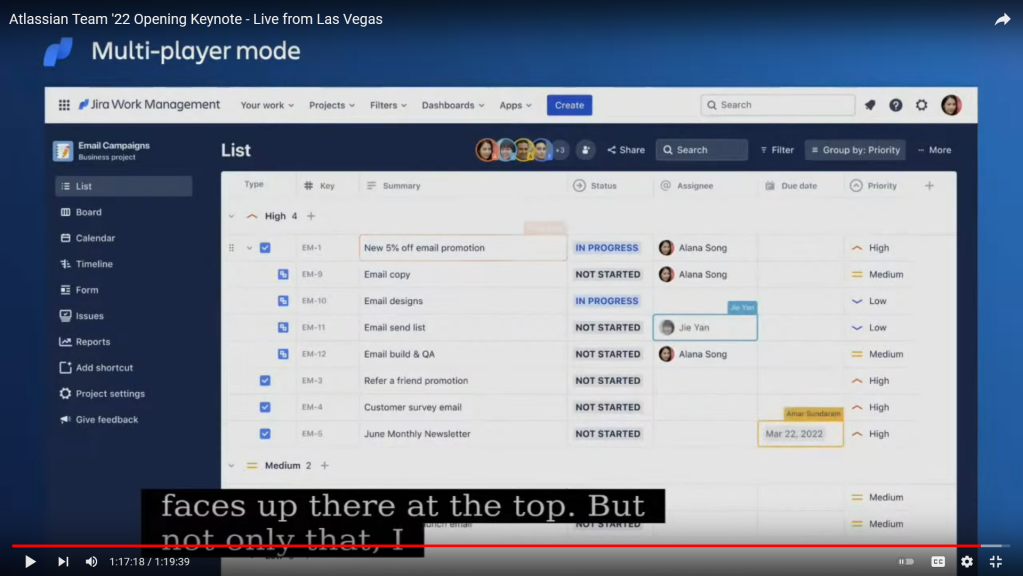
Because Jira Work Management and Jira Software share the same home, you can use Automation to keep tasks in JWM in sync with work happening in Jira Software.

So, recap time. Atlas sounds awesome, but I’m reserved on endorsing it just yet. I still have questions about at which point does it reach enough of a critical mass that you start getting value out of it. With Trello, you can get value out of it as an individual. Jira and Confluence reach that point when everyone on your immediate team is using it. But Atlas, it seems like the entire company needs to use to get value out of it. I might be wrong, and I’ve already signed up for the Beta to see for myself.
Confluence is getting some exciting new features, as is Trello and Jira Work Management. I definitely like the way they are moving. I wish we had more news on Data Center – we know Jira 9.0 is in Early Access, but details on what’s new about it (other than a new number) is hard to find. But I plan to have some comments on that next week.
So, this was our first two Keynotes recapped, and we still have two more that I’ve captured Screenshots for, but need to write up. But they will have to wait until after work today. In the meantime, my name is Rodney, asking, “Have you updated your Jira issues today?”
